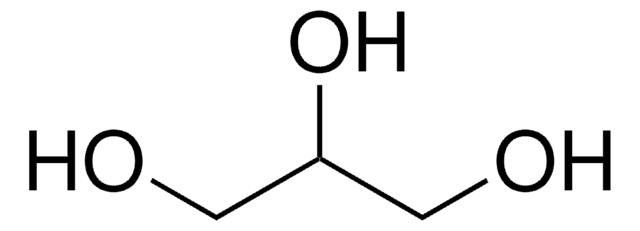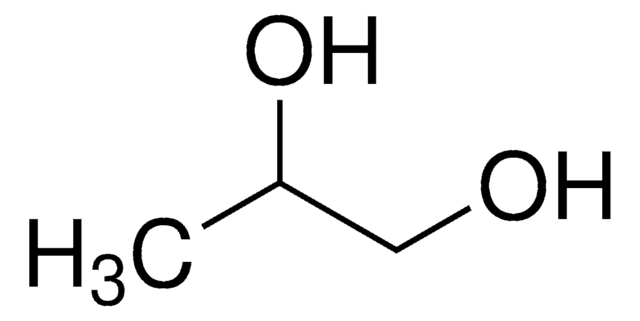G2289
Glycerol
meets USP testing specifications
Synonym(s):
Glycerol, 1,2,3-Propanetriol, Glycerin
About This Item
Recommended Products
product name
Glycerin, meets USP testing specifications
biological source
plant (palm)
Quality Level
agency
USP/NF
meets USP testing specifications
vapor density
3.1 (vs air)
vapor pressure
<1 mmHg ( 20 °C)
assay
99.0-101.0% anhydrous basis
form
viscous liquid
autoignition temp.
698 °F
technique(s)
cryopreservation: suitable
immunofluorescence: suitable
impurities
<0.01% Ash
<5% water (Karl Fischer)
refractive index
n20/D 1.474 (lit.)
bp
182 °C/20 mmHg (lit.)
mp
20 °C (lit.)
solubility
water: miscible
density
1.25 g/mL (lit.)
application(s)
agriculture
life science and biopharma
pharmaceutical (small molecule)
sample preparation
SMILES string
OCC(O)CO
InChI
1S/C3H8O3/c4-1-3(6)2-5/h3-6H,1-2H2
InChI key
PEDCQBHIVMGVHV-UHFFFAOYSA-N
Looking for similar products? Visit Product Comparison Guide
General description
Application
- as a cryoprotectant in the sample medium for research related to plant physiology
- as an optical clearing agent in a study about harmonic generation microscopy
Features and Benefits
- Can be used in Metabolomics and Biochemical research
- High-quality compound suitable for multiple research applications
Other Notes
comparable product
wgk_germany
WGK 1
ppe
Eyeshields, Gloves, multi-purpose combination respirator cartridge (US)
Choose from one of the most recent versions:
Certificates of Analysis (COA)
Sorry, we don't have COAs for this product available online at this time.
If you need assistance, please contact Customer Support.
Already Own This Product?
Find documentation for the products that you have recently purchased in the Document Library.
Customers Also Viewed
Protocols
Separation of L-Alanine; Glycine; L-Valine; L-Leucine; L-Isoleucine; L-Proline; L-Methionine; L-Serine; L-Threonine; L-Phenylalanine; L-Aspartic acid; L-4-Hydroxyproline; L-Cysteine; L-Glutamic acid; L-Asparagine; L-Lysine; L-Glutamine; L-Histidine; L-Tyrosine; L-Tryptophan; L-Cystine
Our team of scientists has experience in all areas of research including Life Science, Material Science, Chemical Synthesis, Chromatography, Analytical and many others.
Contact Technical Service


